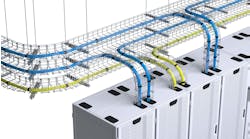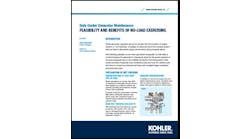DCF Trends Summit Convenes Equinix, Oklo, Nano Nuclear Experts on Data Center Nuclear Energy Frontier
RESTON, Va. -- This part of northern Virginia, where the Data Center Frontier Trends Summit is happening at the Hyatt Regency Reston, is home to a massive new build of data centers. The paradigm around data center location has long been focused on the proximity to fiber-optic, but that is changing to consider siting new facilities where the ample electric power generation can be found.
“Virginia is doing great with data centers, but all of that [power] cannot be delivered,” noted Ralph Hunter, CEO of Orion Nuclear Energy Corp. and a former executive at nuclear generation owner utility Constellation Generation Development.
“You guys,” Hunter added, motioning to the crowd of data center developers, builders and suppliers, “will start going to different states.”
Not Your Parents’ Nuclear
America’s coal-fired power generation fleet is in decline and almost certainly never to revive. Gas-fired power can only go so far if the nation wants to maintain a diverse portfolio of fuel resources. Solar and wind are intermittent and cannot guarantee a flexible, dependable supply of energy.
Enter nuclear, saddled with its longtime dangerous image that inspires fearsome memories of Chernobyl, Fukushima and Three Mile Island, and is surrounded by imagined miles and miles of radioactive, thousand-year waste. The truth is that those first two disasters were magnified by both severe human error and extraordinary circumstances, while Three Mile Island garnered chilling negative publicity but in reality did relatively little damage.
Non-weaponized nuclear energy in the U.S. has powered Navy submarines for decades. Reactors also have generated close to a fifth of total utility-scale electricity, with far fewer of the respiratory or other health issues derived from clouds of coal-fired emissions.
On the waste issue, as the U.S. Department of Energy has pointed out, decades of nuclear fission haven’t yielded more than a football field’s worth of waste nationwide.
On many levels small modular reactor (SMR) nuclear may seem to make business sense. SMRs are clearly far more expensive and take longer to build than gas-fired power or diesel gen-sets, but the nation’s current fleet of utility-scale nuclear plants have performed ably for decades, generating more than half of the carbon-free power in the U.S. The ultimate dollar per MWh is fairly competitive.
SMRs are also designed to be cheaper and safer than traditional nuclear fission plants, such as the recent estimated $33 billion Vogtle expansion in Georgia. The next generation of advanced reactors would be powered by a more efficient fuel, built deeper in the ground and generate between 25 MW to 50 MW, on average, per unit.
“Nuclear is way more versatile” and reliable than other carbon-free fuels, James Walker, CEO of microreactor developer Nano Nuclear Energy, said during the Data Center Frontier Trends Summit session. “China came to this conclusion years ago, and they are building nuclear like crazy. They need that consistent power.”
So does the U.S., which may or may not choose SMR nuclear but has no choice but to find a way to match a forecast 40 GW of data center capacity growth over the coming decade. Advanced nuclear already is being pursued, in very early stages of course, by major industrial and technology firms from Dow to Amazon Web Services to Microsoft.
Nuclear fuel bottlenecks, both spent and otherwise, will be a solved problem with a tighter uranium supply chain in the coming decade, said Brian Gitt, head of business development for SMR designer Oklo. The U.S. government has allocated $2.7 billion toward domesticating the uranium supply line instead of importing from Russia and other sources.
Oklo also plans to build a recycling facility for spent fuel rods. Some 90% of available energy is still in those small cylinders, he estimated.
“We could power the U.S. for the next 150 years just leveraging that spent fuel,” Gitt predicted. “It’s not new technology; it’s just the will to do it.”
Nuclear Microgrids vs. NIMBY
Nuclear-powered microgrids make sense on several financial and locational levels, proponents have said. For one thing, it helps companies deliver on net-zero emission promises in a more direct way than virtual power purchase agreements that invest in remote renewable energy projects.
For another, building SMRs closer to the customer load eliminates massive expense in transmission lines and other grid infrastructure common to utility-scale renewables and more distant power plants.
“It can be done and will be done,” Walker said.
One reason it might not be done is the formidable, yet old “Nimby” argument rearing its head: Not In My Back Yard. Residential and commercial customers, understandably wary of radioactive power resources will not go gently into that good night of nuclear power acceptance.
So, projects must be rationally considered, carefully and remotely sited. They need a business case that demonstrates the promise of future revenues from subscribed customers.
The road for future SMR nuclear microgrids is narrow but passable.
“It’s an emotional issue,” Orion’s Hunter said. “From a practical point you need to find a location for SMR and data centers which won’t have that problem [of stiff commercial and residential resistance].”
Emotions, in their own way, are as powerful as reactors, and inertia is hard to overcome without a new force acting on it. Education, the panel agreed, is the tool to move SMR nuclear microgrids forward.
“The misconceptions of what nuclear is are huge,” Walker said. “We have a lot of facts on our side.”
Emotion doesn’t always listen to facts in evidence. The moderator of the Data Center Frontier Trends Summit session, Ali Ruckteschler, chief procurement officer at digital infrastructure firm Equinix, pointed out that education also should be aided by regulators who truly understand what’s at stake if data center capacity growth is slowed or stalled.
“Push it on regulators to help educate people,” she said. “We need help in educating people [to understand] that without that data center you can’t work on your phone, you can’t get on that Zoom call. Is that what you want?”
Now that’s a future most people cannot comprehend.
The full panel of nuclear specialists assessing the prospects for SMRs and data centers at the Data Center Frontier Trends Summit included:
- Ali Ruckteschler of Equinix (moderator)
- Brian Gitt of Oklo Inc.
- James Walker of Nano Nuclear Energy Inc. (NASDAQ: NNE)
- Stephen Middlekauff of Schweitzer Engineering Laboratories (SEL)
- Ralph Walker of Orion Nuclear EnergyThe panelists noted that the safety and viability of SMR/microreactor technology has been established in submarines and universities, but that the regulatory landscape and public perception remain challenging.
What's the 10-year outlook?
The panelists said they expect to see MegaCampuses powered by multiple SMRs, perhaps in a N+1 config with the spare selling power to the grid when not in use.
"Advanced nuclear is going to be standard for data centers in the future," said Gitt.
Equinix wants to purchase hundreds of megawatts of power from Oklo. The California-based nuclear fission startup is backed by OpenAI founder and CEO Sam Altman, and aims to manufacture streamlined SMR technology for data center and industrial energy generation.
Oklo's stated mission is "to provide clean, reliable, affordable energy on a global scale through the design and deployment of next-generation fast reactor technology." The company adds that it is pursuing an owner-operator model with an intention to sell power directly to customers under long-term contracts, providing a source of recurring revenue.
Oklo expects its SMRs to generate up to 15 MW of power, while operating for more than a decade without refueling. While the collaboration with Equinix is still at the letter-of-intent stage, the data center company has reportedly committed $25 million in the deal so far. -- Matt Vincent

Rod Walton
Rod Walton is Managing Editor of Endeavor Business Media's Microgrid Knowledge and EnergyTech, publications focused on the sustainability and resiliency goals of mission-critical and large-scale energy users, including the commercial and industrial sectors, as well as the military, universities and data centers.

Matt Vincent
A B2B technology journalist and editor with more than two decades of experience, Matt Vincent is Editor in Chief of Data Center Frontier.





